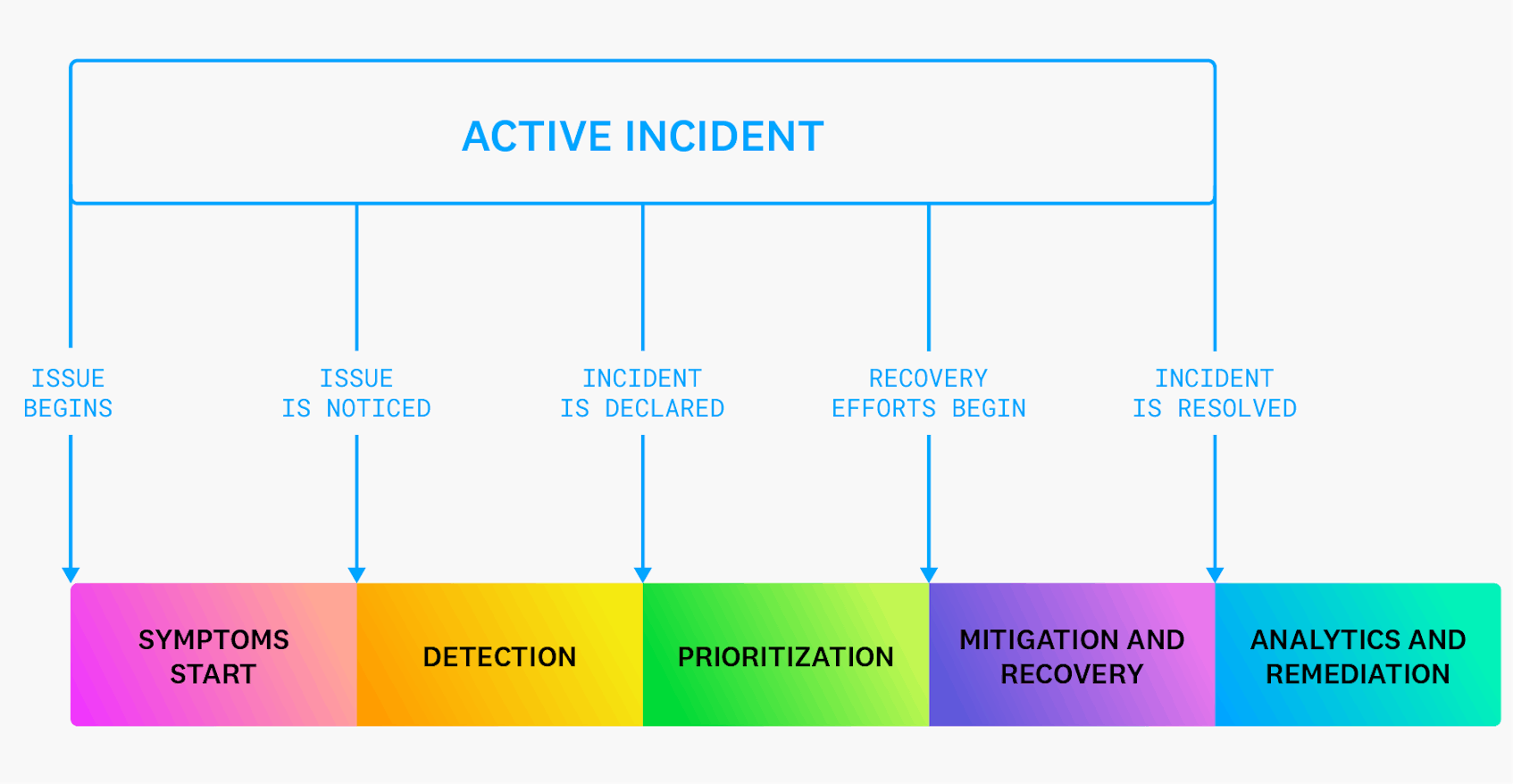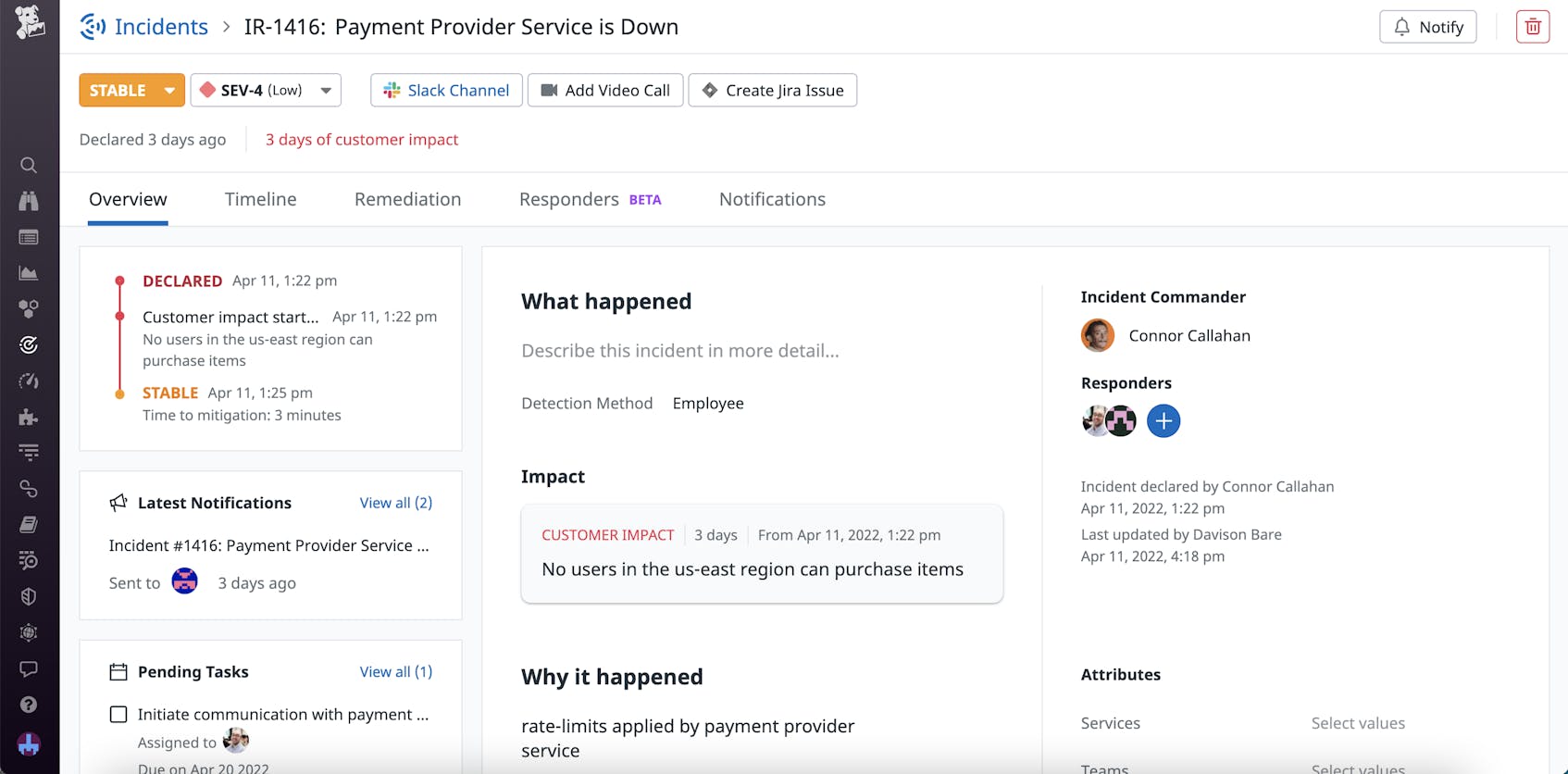What Is Incident Management?
Incident management is a framework that encompasses the procedures, tools, and metrics your organization uses to identify and respond to unplanned IT events. Organizations can use incident management to streamline their response procedures, reducing mean time to repair (MTTR) and minimizing any impact on end users. In this article, we’ll explore how you can use incident management to efficiently detect, resolve, and analyze system issues.
How Does Incident Management Work?
When implemented effectively, incident management gives your response process structure, making it easier to evaluate and refine. Practicing good incident management means considering who is involved in a response, what solutions they use, and any measures that could prevent future problems. A unified incident strategy can help you organize these considerations under a single model. While incident management is flexible and should reflect the specific needs of your team, well-designed plans usually account for these basic needs:
Detection: recognizing and reporting events quickly and accurately to ensure that every system issue is caught and sent to the appropriate responders.
Prioritization: identifying the severity of an incident to determine next steps, including how many responders need to be brought in, who needs to be notified, and how soon a solution needs to be provided.
Mitigation and Recovery: working with teams across the organization to contain the damage, then sifting through system data—including metrics, logs, and metadata—to find the root cause and troubleshoot potential fixes.
Analytics and Remediation: studying the incident to create useful postmortem documentation and take steps to prevent future incidents.
Incident Management Use Cases
Incident management encourages teams to take an organized approach to handling and analyzing issues. Without incident management, responders often default to a patchwork of existing tools designed for non-incident work, creating more opportunities for miscommunication or mistakes. Distributed systems only add to this complexity, introducing specialized resources that require even more coordination.
By enabling the adoption of unified tools and processes, incident management can help teams across your organization:
- Responders
The most immediate and pressing use case is resolving an active issue. Incident management helps teams design flexible response procedures that can be scaled to minor or severe issues. This gives responders a clear set of steps to follow during stressful situations, reducing overall MTTR and the potential for human error.
- Stakeholders
Depending on the nature of the incident, business stakeholders may need to relay information to impacted customers. Having open communication channels with responders and access to postmortem reports gives stakeholders the details they need to make effective decisions.
- Leadership
Organization leaders can use incident trends to re-evaluate their engineering priorities. Since frequent issues may impact your user experience, understanding incident trends is crucial to improving the reliability of your product and overall customer satisfaction.
Benefits of Incident Management
With incident management, you can develop adaptable response strategies that integrate with your workflows. Effective incident management can help you:
- Streamline troubleshooting
Good incident management plans include repeatable resolution processes that responders can follow. Not only does this help you find the root cause of a problem faster, but it also enables you to onboard new responders more efficiently.
- Share knowledge
Once an issue has been resolved, incident management can simplify sharing findings and lessons with other engineers through coordinated runbook and postmortem documentation. In addition to helping teams get up to speed soon after an incident, these writeups can also serve as references when dealing with similar issues in the future.
- Analyze historical trends
Studying past incidents can help business and engineering teams prevent future ones. This often includes looking at patterns in incident response metrics over time, such as MTTR, service resiliency, and issues by application or service.
Challenges of Incident Management
Despite these benefits, incident management can also create challenges you should consider, especially when implementing new procedures and tools. These obstacles can include:
- Process definition
Moving to a formalized incident management process involves defining key steps and evaluating the efficacy of current strategies. It can be particularly hard for teams to translate these procedures into plans that larger groups can follow.
- Onboarding
Once you have a process in place, you have to teach it to new responders. Crafting training materials, designating onboarding tasks to team members, and compensating for the time it will take trainees to learn and adapt to the system can lead to further complications.
- Process buy-in
Even after teams fully implement a new process and onboarding plan, responders’ muscle memory and reluctance to switch from established workflows can impact the effectiveness of a formalized strategy.
Incident Management Tools
To address the challenges listed above and get the most out of your incident management system, you should maintain a set of integrated tools and procedures to streamline the adoption of your process. Incident management tools should facilitate collaboration between teams and provide a centralized location for all response activity, keeping your process well-defined and intuitive for any team member to respond quickly and effectively. When researching solutions, you’ll want to look for:
- Automated stakeholder notifications
Effective incident communication means keeping multiple stakeholders up-to-date as the situation progresses. Incident management offerings with native, automated notifications free up responders to focus on finding a fix while keeping all relevant parties in the loop.
- Incident timelines
Having a single source of truth for an incident can serve as a useful point of reference, both when troubleshooting and creating postmortems. Incident timelines allow you to easily visualize how the issue unfolded and see which actions were taken when. Responders should be able to view metrics alongside the events that generated them so they don’t miss important context.
- Communication tools
Chat tools ensure that responders can quickly relay essential information. To facilitate smooth communication, chat features should be integrated with other incident management solutions.
- Postmortem generation
Postmortems are crucial to knowledge sharing, but creating them can be a tedious task. Additionally, relying solely on responders’ memories of an incident may lead to important details being excluded. Incident management tools can automatically populate postmortem templates with data gathered during the response to optimize this process.
- Analytics
While frustrating, incidents also provide your organization with valuable information. Incident analytics can help you decide whether you need to reassess department priorities or team resources based on the reliability of your services.
Datadog Incident Management provides all these features to help you detect, resolve, and analyze issues fast. You can view incidents in a single pane of glass, right next to relevant monitors and metrics. Incident Management integrates with Slack to simplify messaging and notifications, and you can update incidents either directly in the Datadog app or via Slack commands. When the incident is resolved, Datadog Notebooks allows you to automatically generate postmortems with incident details and view a list of remediation tasks.
Use our documentation to get started with Incident Management today.





